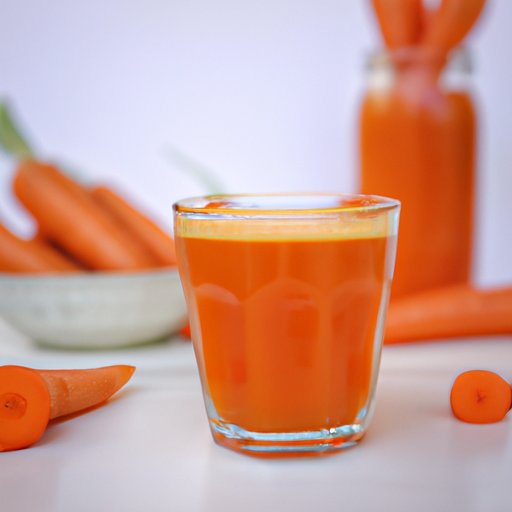
I. Introduction
Carrot juice has become a popular beverage in recent years, thanks to its numerous health benefits and delicious taste. If you’re looking for a refreshing and nutritious drink, carrot juice is an excellent choice. Not only is it packed with vitamins and minerals, but it’s also easy to make at home with just a few simple steps. In this article, we’ll take a closer look at how to make carrot juice, its health benefits, recipe ideas, cultural significance, and sustainability.
II. Step-by-Step Guide
Equipments and Ingredients Needed
To make carrot juice, you’ll need a few essential pieces of equipment, including a juicer, a knife, a cutting board, and a strainer. You’ll also need fresh carrots, which can be found at your local grocery store or farmers’ market.
Preparing the Carrots for Juicing
Before juicing your carrots, it’s essential to wash them thoroughly and remove any dirt or debris. You can peel the carrots if desired, but this is not necessary. Cut the ends off the carrots and slice them into small pieces that will fit in your juicer’s feed chute.
Juicing the Carrots
Once your carrots are prepared, you’re ready to start juicing. Follow the instructions for your specific juicer model, but as a general rule, feed each carrot piece into the juicer one at a time. Use a spoon or spatula to press the carrot pulp against the juicer’s strainer to extract the maximum amount of juice.
Tips and Tricks for Different Methods and Flavor Variations
If you don’t have a juicer, you can still make carrot juice at home using a blender and cheesecloth. Blend the carrots with water until smooth, then strain the mixture through the cheesecloth to remove any pulp. To add extra flavor to your carrot juice, try adding ingredients like ginger, lemon, apple, or celery.
III. Health Benefits
Nutrients Found in Carrots and Their Benefits for Overall Health
Carrots are rich in a variety of nutrients that are essential for good health, including vitamin A, vitamin K, folate, and potassium. These vitamins and minerals can help support healthy vision, skin, bones, and immune function.
How Carrot Juice Can Help With Weight Loss, Digestion, and Other Health Issues
In addition to its high nutrient content, carrot juice may also have some unique health benefits. Studies suggest that drinking carrot juice may aid in weight loss, promote healthy digestion, and even reduce the risk of certain types of cancers.
IV. Recipe Roundup
Classic Carrot Juice with Ginger and Lemon Recipe
To make a classic carrot juice recipe with ginger and lemon, you’ll need:
- 6-8 medium-sized carrots
- 1-inch piece of fresh ginger root
- 1/2 lemon
Follow the steps outlined above to prepare and juice your carrots. Add the ginger and lemon to the juicer with the carrot juice, and mix well. Serve over ice for a refreshing drink.
Unique Recipes That Incorporate Other Fruits or Vegetables
If you’re feeling adventurous, try adding different fruits or vegetables to your carrot juice for a unique flavor. Some great options include:
- Carrot, apple, and beet juice
- Carrot, orange, and ginger juice
- Carrot, spinach, and pear juice
V. History and Cultural Significance
The origins of carrot juice can be traced back to ancient Persia, where it was used as a medicinal remedy. Over time, it became popular in other parts of the world, including Europe and the United States. Today, carrot juice is enjoyed by people of all ages and cultures, and it is often associated with health and wellness trends.
VI. Sustainability
How to Choose the Most Sustainable Carrots for Juicing
When shopping for carrots to juice, it’s important to look for those that are organic and locally grown. This helps to support sustainable farming practices and reduce your carbon footprint.
Ways to Reduce Waste By Using the Pulp Leftover From Juicing
After juicing your carrots, you may be left with a significant amount of pulp. Rather than throwing it away, try using it in recipes like soups, stews, or baked goods. You can also compost the pulp to create nutrient-rich soil for your garden.
VII. Conclusion
Carrot juice is an easy and delicious way to support your overall health and wellness. By following this step-by-step guide, you’ll be able to create your own nutritious and flavorful carrot juice at home. Whether you prefer classic recipes or more creative flavor combinations, there’s a carrot juice recipe out there for everyone.





